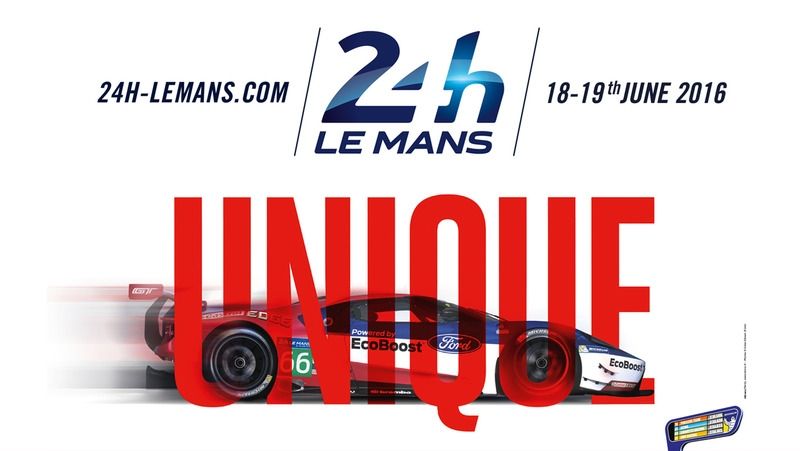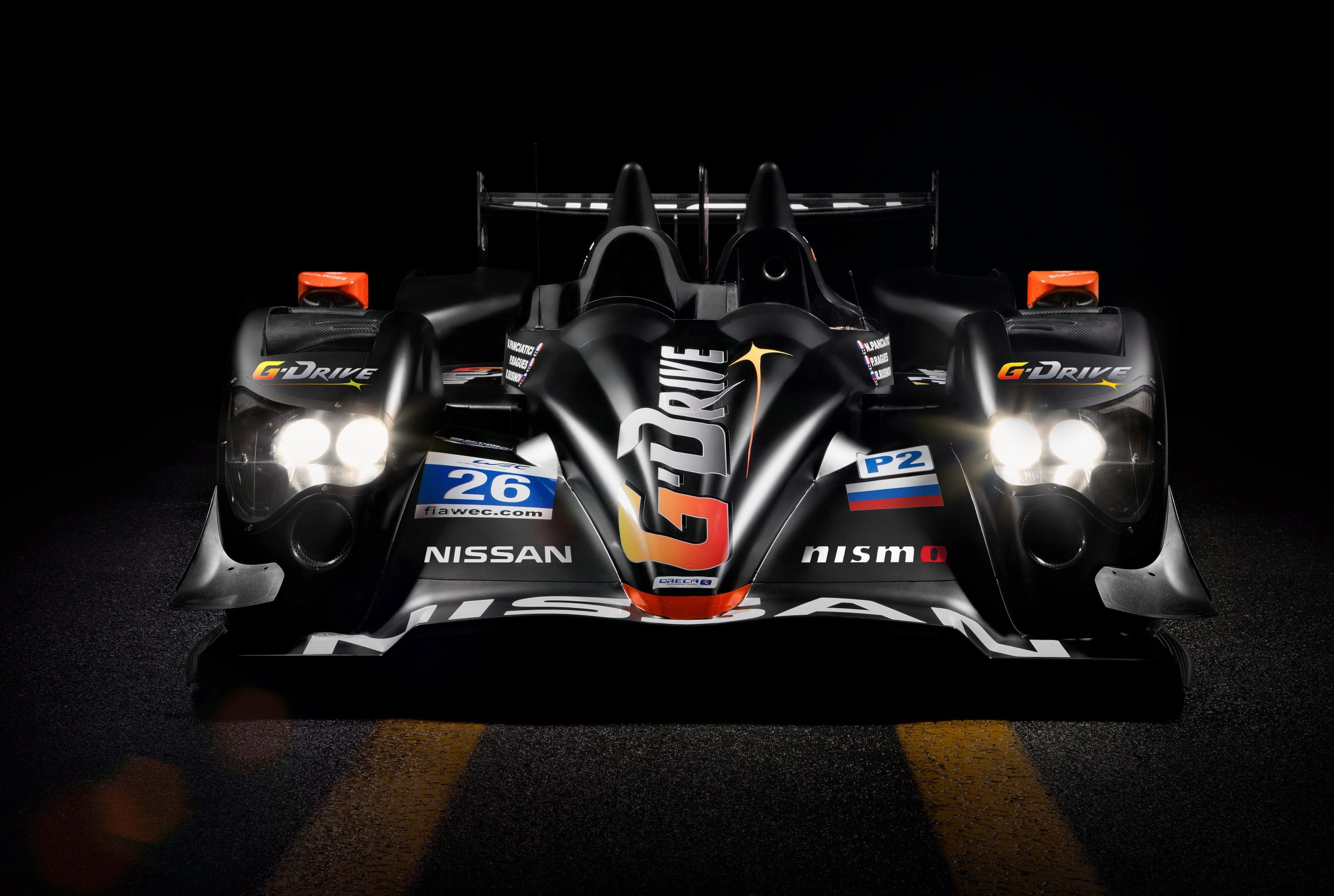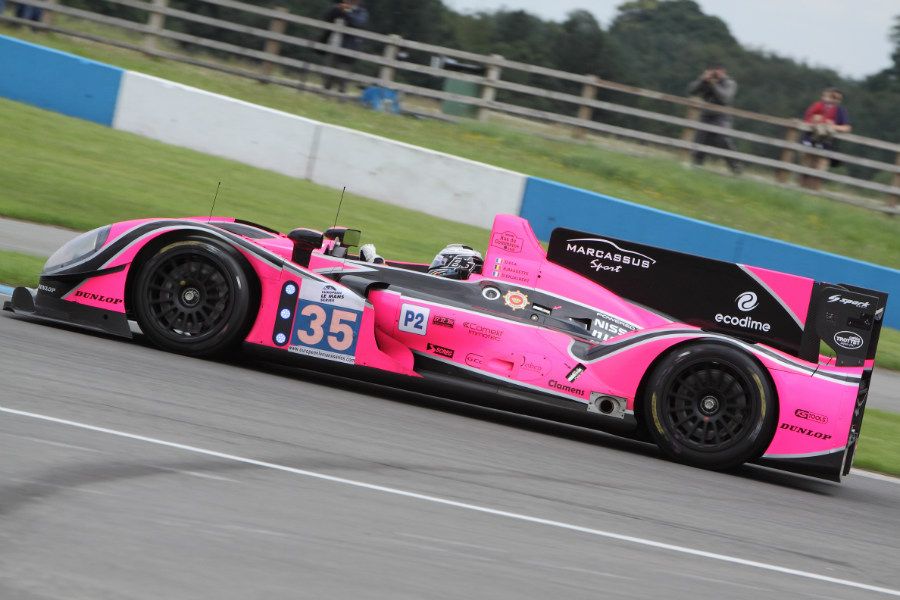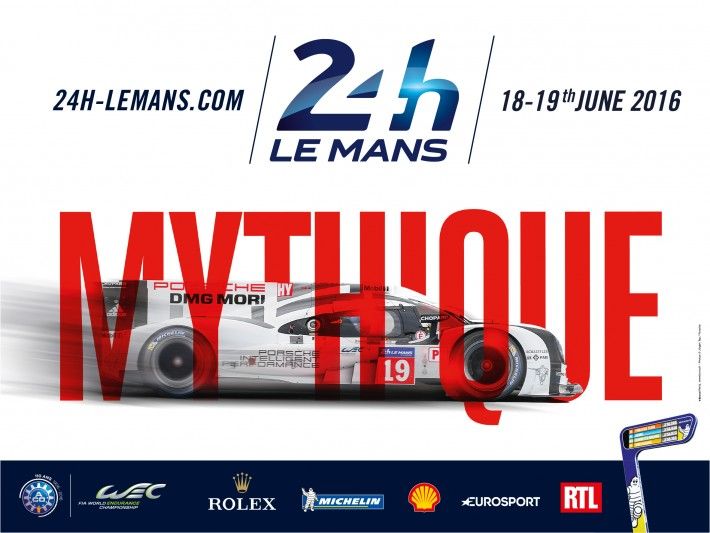No other race in the world manages to capture the public’s imagination quite like the 24 Hours of Le Mans. Even when placed alongside the Monaco Grand Prix and Indy 500, the two remaining trophies in the Triple Crown of Motorsport, the 24 HOLM is simply a cut above in terms of scope, challenge, and spectacle. “Epic” is just the baseline here – four categories of race cars take to the track at once, with “traffic” complicating individual maneuvers for position within each respective class. A mix of tight corners and ultra-long straights make race car set-up a battle in and of itself, while the prolonged runtime stresses man and machine to the max. The best drivers in the world are called upon to participate, some of which lose upwards of 6.5 pounds by the end of their final stint. Simply put, the 24 HOLM creates legends.
This year will be the 84th running of the highly celebrated motorsport event. Also acting as the third round of the FIA World Endurance Championship, the 2016 24 HOLM includes a field of 60 vehicles, equaling records from the ‘50s for the race’s largest all-time grid. Going for glory will be 180 drivers from 27 different countries, including 23 Americans.
But of course, the 24 HOLM is just as much about the stories as it is the numbers. Stateside fans will no doubt tune in to watch the new Ford GT compete in the LM GTE Pro class, marking 50 years since the automaker’s renowned 1-2-3 finish against Ferrari. Then there’s the LMP1 class, where Audi will challenge Porsche to retake top honors after it was dethroned last year. Meanwhile, Frederic Sausset, a quadruple amputee, will compete in LMP2 with a specially modified Morgan.
We’ve got the lowdown on everything you need to know about the 2016 24 HOLM, including track info, the classes, the cars, the drivers, where to watch, and even a little history. Read on for the details.
Continue reading to learn more about this year’s 24 Hours of Le Mans.
The Track
In many ways, the Circuit de la Sarthe is a unique track. Set in Northern France, it employs sections of local roads that are open to the public throughout most of the year, which can lead to less than ideal grip levels. In its current configuration, a single lap distance is 8.47 miles, making it one of the longest racing circuits in the world. Despite the addition of several chicanes, the track also employs extremely long straights, with drivers spending 85 percent of each lap at full throttle.
This makes for absurdly high speeds (Roger Dorchy achieved a record 253.1 mph in a Peugeot in 1988), which means a well-balanced aerodynamics package is particularly important. The high speeds also put tremendous strain on mechanical components, with engines maxed down the straights, and the brakes, suspension, and tires maxed when slowing down at the end of them.
The result is an ideal battleground for endurance racing, lending credence to the phrase “to finish first, you must first finish.”
LMP1
At the top of the Le Mans totem pole is the LMP1 class, where we find the most advanced technology and the highest speeds. This is where the big manufacturers like to throw their weight around, each aiming to outdo one another for the ultimate in endurance racing bragging rights.
This year, Porsche, Audi, and Toyota will head the class. All three of these factory teams will have just two cars on track, placing an even greater emphasis on reliability. Identified by a red and white number plate and the letters “HY”, all of the manufacturer LMP1 cars come equipped with a hybrid drivetrain making roughly 1,000 horsepower. Meanwhile, the privateers race in non-hybrids. Only closed cockpits are allowed, but there are no requirements in terms of production numbers. Minimum vehicle weight is set at 875 kg (1,929 pounds) for the hybrids and 850 kg (1,874 pounds) for the non-hybrids. A 0-to-60 mph sprint clocks in at just over 2 seconds. A run to 120 mph takes less than 5 seconds. Top speed depends on the aero package, but it’s safe to assume a number north of 200 mph.
Porsche 919 Hybrid
Car #1 Drivers: Timo Bernhard, Mark Webber, Brendon Hartley
Car #2 Drivers: Romain Dumas, Neel Jani, Marc Lieb
Last year, Porsche disrupted the LMP1 status quo by defeating Audi, putting an end to the Four Rings’ five-peat winning streak. Although it was Porsche’s first win since 1998, the 2015 result was Stuttgart’s 17th overall victory at Le Mans – the most of any manufacturer in the history of the event. Now in the third year of its return to the sport, Porsche hopes to maintain its champion status with a record 18th win.
Stuttgart’s hopes are pinned on the third-generation 919 Hybrid. While the carbon-fiber monocoque is more or less unchanged compared to last year’s car, the turbocharged 2.0-liter V-4 engine was lightened and made to be more fuel-efficient. Porsche also added new aerodynamics packages that were specifically tuned for each individual circuit (low-downforce settings for Le Mans), and there’s a new livery. Meanwhile, the energy recuperation system (braking energy in front, exhaust energy in back) is the same.
Porsche managed to take a win at the opening WEC round in Silverstone, but only after Audi was excluded from the results due to non-compliance (the front skid block on the No.7 Audi was overly worn). You can be sure Audi won’t let a technical oversight like that happen again, especially at Le Mans, which means Porsche will need to bring its A game if it wants a repeat of last year.
Read our full review on the 2016 Porsche 919 Hybrid here.
2016 Audi R18 E-Tron Quattro
Car #7 Drivers: Andre Lotterer, Benoit Treluyer, Marcel Fassler
Car #8 Drivers: Lucas di Grassi, Loic Duval, Oliver Jarvis
Last year, Audi managed to get on the podium, but only just (the top R18 barely squeaked across the finish line in third). However, with 13 of the last 16 events ending in victory for the Four Rings, the marque should still be considered extremely dangerous – especially with a new ride on the grid.
According to Audi, the new R18 was designed from the ground up specifically for the 2016 season, and shares “almost nothing” with last year’s car. That means new aero, a new safety cell, a new battery-operated hybrid system, and an updated diesel V-6. The result is the most powerful (not to mention most fuel-efficient) racecar that Audi has ever built.
At Spa, during the second round of this year’s WEC season, the new R18 clinched its very first victory. But while it clearly has the speed, the fresh racer might not have the reliability needed to charge past Porsche. The potential is clearly there, but whether or not it’ll translate into a win remains to be seen.
Read our full review on the 2016 Audi R-18 E-Tron Quattro here.
Toyota Gazoo Racing TS050 Hybrid
Car #5 Drivers: Anthony Davidson, Sebastien Buemi, Kazuki Nakajima
Car #6 Drivers: Stephane Sarrazin, Mike Conway, Kamui Kobayashi
Although outright victory at Le Mans has so far escaped Toyota, the Japanese manufacturer is definitely capable of taking home the win. The 2014 WEC season proved exactly that, as Toyota won five of the eight races on the docket, handing it championship titles in both the manufacturer’s and driver’s championships.
Unfortunately, 2015 was a bit more middle-of-the-road for Toyota, with a fifth-place finish in the driver’s championship, third in the manufacturer’s championship, and a top sixth-place finish at Le Mans. But as you might expect, Toyota has improved its Gazoo Racing hybrid since last year.
Framed as the third-generation vehicle since Toyota joined the WEC in 2012, the TS050 uses a twin-turbo 2.4-liter V-6 gas engine mated to an 8-megajoule hybrid system, with brake energy recovery in the front and rear. The 7-speed sequential gearbox was upgraded to handle the powerplant’s increased torque output, and the carbon fiber aero was totally reworked.
Basically, it’s a brand-new car. At the opening round in Silverstone, Toyota finished behind both Audi and Porsche, but managed to secure a third-place podium at Spa. Could this be Toyota’s year take the number-one spot at Le Mans?
Read our full review on the 2016 Toyota TS050 Hybrid here.
LMP2
Cars competing in the LMP2 class look remarkably similar to those in LMP1, and indeed, there are several parallels. However, LMP2 caters specifically to teams without backing from a major manufacturer, and limits are placed on spending to keep the playing field somewhat level.
Identified by a blue and white number plate, LMP2 cars can have either an open or a closed cockpit. Once again, there are no production minimums required. Minimum weight is a bit higher than LMP1, set at 900 kg (1,984 pounds), while downforce and power levels are lower. Both diesel and gasoline engines are allowed, with naturally aspirated applications limited to eight cylinders and 5 liters of displacement. Boosted gasoline engines are also allowed, but are limited to six-cylinder configurations and 3.2 liters of displacement. Hybrids are not allowed.
This year, the LMP2 class is the biggest of the four, contributing over 20 entries prepped to take the green.
KC Motorgroup Oreca 05-Nissan
Car #47 Drivers: Matt Howson, Richard Bradley, Tsugio Matsuda
Hong Kong-based KCMG clinched the LMP2 win at Le Mans last year, making it the defending champion for 2016. Joining the driver roster this year is Tsugio Matsuda, a titleholder from the Japanese Super GT series. Although the Oreca 05-Nissan racecar is unchanged this season, having sat unused since November, it’s still looking fast in testing. Whether or not KCMG will go back-to-back is uncertain, but either way, look for the #47 car at the front of the LMP2 pack.
G-Drive Racing Oreca 05-Nissan (#26), Gibson 015S-Nissan (#38)
Car #26 Drivers: Roman Rusinov, Rene Rast, Will Stevens
Car #38 Drivers: Jake Dennis, Simon Dolan, Giedo van der Garde
G-Drive is a consistent top-performer at Le Mans, snatching third last year, and narrowly missing a win in 2014. This year, with two cars in the running, G-Drive is once again a favorite for the win, especially with former Formula 1-talent Will Stevens and 24 HOLM-competitor Rene Rast at the wheel.
Abu Dhabi-Proton Racing Morgan LMP2-Nissan
Car #84 Drivers: Frederic Sausset, Christophe Tinseau, Jean-Bernard Bouvet
Without a doubt, the most inspirational story to come from the 2016 24 HOLM is that of Frederic Sausset. In 2012, Sausset developed a condition called purpura fulminans, resulting in the amputation of both his hands and legs. After nearly succumbing to the illness, Sausset recovered, leaving the hospital in 2013. Despite being a quadruple amputee, the middle-aged Frenchman decided to follow through on his dream of racing at Le Mans, and this year, that dream will come to fruition.
Sausset will pilot a specially modified Morgan using a prosthetic arm for steering and seat-mounted pedals for the brake and throttle. The modifications are removable, allowing Sausset’s co-drivers to take over after his stint is complete.
Sausset and his team will race under the experimental Garage 56 designation. Look for the black and white “84” number plate.
LM GTE Pro
Unlike the prototypes, the GT cars are a little closer to something you can pick up at the showroom. Heading the production vehicles is the GTE Pro class, where two-door sports cars do battle with professional drivers at the helm.
Designated by green and white number plates, the GTE Pro cars must use their original production-based engine platform, with displacement limited to 5.5 liters for naturally aspirated powerplants, and 4 liters for forced induction powerplants. Gearboxes must have no more than six forward gears, and AWD is not allowed. Exotic materials like titanium, magnesium, and even carbon fiber are banned, although there are exceptions for specific parts (such as aerodynamics and wheels). The minimum vehicle weight is 1,245 kg (2,744 pounds). The cars can also be identified at night thanks to their yellow headlights.
Of course, the higher-ups can change any of these rules to keep the field as competitive as possible.
Chip Ganassi Ford GT
Car #66 Drivers: Olivier Pla, Stefan Mucke, Billy Johnson
Car #67 Drivers: Marino Franchitti, Andy Priaulx, Harry Tincknell
Car #68 Drivers: Joey Hand, Dirk Muller, Sebastien Bourdais
Car #69 Drivers: Ryan Briscoe, Richard Westbrook, Scott Dixon
Unless you’ve been living under a rock for the last year, you’ve no doubt heard about Ford’s return to Le Mans. With no less than four entries on the grid (each of which bears a number referencing Ford’s winning streak between 1966 and 1969), the Blue Oval certainly has the odds in its favor.
But even with so many cars competing for the win, the new Ford GT still needs to prove it has what it takes to succeed in the 24-hour challenge. Although the car already scored its first competitive victory at Laguna Seca earlier in May, the opening round of the WEC season saw Ford grab a fourth- and fifth-place finish, while round two at Spa ended with a second-place finish and a DNF.
The results may be impressive for an automaker’s first season back in the saddle, but it’s not quite the dominating performance Ford was hoping for. We’ll have to wait and see if history repeats itself in France.
Read our full review on the 2016 Ford GT Le Mans here.
Corvette Racing–GM C7.R
Car #63 Drivers: Jan Magnussen, Antonio Garcia, Ricky Taylor
Car #64 Drivers: Oliver Gavin, Tommy Milner, Jordan Taylor
Last year, the #64 ‘Vette took home all the star-spangled glory with outright victory in the GTE Pro class, and so far, it’s looking quite possible the same will happen again in 2016. If successful, it’ll mark a ninth win for the Corvette Racing team.
Testing so far has placed the GM vehicles at the head of the pack, with the #63 car setting the fastest lap in-class, followed by the #64 car in fourth. Both Corvettes feature updated aerodynamics for this year’s contest.
Read our full review on the 2016 Corvette Racing C7.R here.
AF Corse Ferrari 488 GTE
Car #51 Drivers: Gianmaria Bruni, James Calado, Alessandro Pier Guidi
Car #71 Drivers: Davide Rigon, Sam Bird, Andrea Bertolini
Without a doubt, the biggest threat to American success at Le Mans comes from AF Corse. After very nearly taking the checkered ahead of the #64 ‘Vette in 2015, the Italians are back, replacing the old 458 racers with brand-new 488s. And although the cars are fresh, AFC has wasted no time in collecting points, scoring back-to-back wins in both opening rounds of the WEC.
AFC brings over two decades of GT racing experience to the table, plus a history of championship titles. And with Ford back in the mix, rest assured nothing will be left in reserve.
Read our full review on the 2016 Ferrari 488 GTE here.
LM GTE Am
The GTE Am class uses the same rules as the GTE Pro class, but adds that cars must be “at least one year old or fully in compliance with the specifications of the previous year car.” Furthermore, driver rosters are restricted to include more amateurs. You can identify GTE Am cars by their orange and white number plates.
Aston Martin Racing V8 Vantage
Car #98 Drivers: Paul Dalla Lana, Pedro Lamy, Mathias Lauda
Car #99 Drivers: Andrew Howard, Liam Griffin, Gary Hirsch
Aston Martin simply dominated the race last year, but failed to finish after the #98 car went off at the Mulsanne Corner in the final hour. This year, AM is back in full force, scoring a second-place finish at Silverstone and a first-place finish at Spa.
Read our full review on the 2016 Aston Martin Racing V8 Vantage here.
How to Experience And The Schedule
How To Experience
The 2016 24 Hours of Le Mans will be broadcast live in the U.S. on Fox Sports, beginning Saturday, June 18th. The broadcast will commence at 8:30 AM on FS1, and will move to FS2 at 2:00 PM. Alternatively, you can stream it via Fox Sports Go here. Find more information on the Fox broadcast here.
You can also listen in to the Radio Le Mans podcast here.
Twitter accounts to follow: @DunlopMSport, @Radiolemans, @24hoursoflemans
Don’t forget to check out the supremely helpful Spotter Guide from Andy Blackmore Design here.
The Schedule
Note: all times are local.
Find the complete schedule here.
Wednesday, June 15th
10:00 AM: Pit walk
4:00 PM: 24 HOLM free practice session
8:30 PM: Road to Le Mans free practice session
10:00 PM: 24 HOLM qualifying session
Thursday, June 16th
10:00 AM: Ferrari Challenge free practice session
10:00 AM: Ferrari Challenge free practice session
11:30 AM: Road to Le Mans free practice session
4:00 PM: Ferrari Challenge qualifying session
2:30 PM: Road to Le Mans qualifying session
4:00 PM: 24 HOLM qualifying session
10:00 PM: 24 HOLM qualifying session
6:00 PM:}
7:00 PM: Drivers Parade
10:00 PM:}
5:30 PM: 24 HOLM warm-up session
9:00 AM: Ferrari Challenge race commence
10:05 AM: Road to Le Mans race commence
11:10 AM: 3:00 PM:}
24 HOLM RACE COMMENCE
11:10 AM: 24 HOLM race end
3:00 PM: Podium ceremony
3:10 PM:0}
The first 24 HOLM was run in 1923, and was originally held on public roads around the French town from which the race derives its name.
After a decade-long hiatus between 1939 and 1949, racing resumed with major factory backing, including entries from Ferrari, Aston Martin, Mercedes-Benz, and Jaguar.
Throughout the ‘50s and ‘60s, vehicle speeds increased substantially, prompting additional safety measures for both the drivers and spectators. One example was the way in which the race started.
Traditionally, a “Le Mans start” saw drivers and cars lined up on opposing sides of the front straight. When the green dropped, the drivers would sprint across the track, enter their car, and get underway.
While exciting, many drivers would ignore safety devices. In 1969, Jacky Ickx protested the tradition by walking to his car while his competitors ran. Privateer John Woolfe died in an accident on the first lap, while Ickx ended up winning. The tradition was changed the following year, and now, the 24 HOLM begins with a rolling start.
The ‘70s saw rapid development of aerodynamics and efficiency technologies, while additional manufacturers, like Japanese marques Toyota, Nissan, and Mazda entered the fray in the late ‘80s.
In the ‘90s, a variety of famous exotic supercars were built to compete in the Grand Touring category, such as McLaren’s F1 GTR. The year 2000 saw the beginning of a dynasty for Audi in the prototype class, which introduced new diesel and hybrid technology to the sport over the course of the following 16 years.






